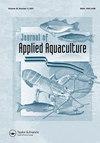淡水贻贝(Lamelliedens edges)减少刺鲶鱼水产养殖中铅(Pb)的生物累积
IF 0.8
Q3 FISHERIES
引用次数: 11
摘要
摘要淡水贻贝(Lamellidens edges)在水族馆中饲养了暴露于亚致死浓度(0.75 mg/l)Pb(NO3)2的刺鲶鱼(异气化石)28天,以评估鱼类的生长、Pb生物累积和相关的肝脏组织病理学。三个处理(T2、T3和T4)和一个对照(T1)分别分配20条鱼和5、20、40和0只贻贝。T3和T4的比生长速率、重量百分比和长度增加显示Pb的增加大于对照和T2。28天后,对照组的肌肉和肝脏Pb含量最高,分别为2.43±0.01 mg/L和7.79±0.8 mg/L(T1);T4最低,分别为0.46±0.07mg/L和4.41±0.58mg/L。肝组织病理学表现为不同强度的空泡化、肝细胞破裂、充血、坏死和脂肪滴积聚。对照组表现为严重病理;T4治疗表现出相对较低的体征。本文章由计算机程序翻译,如有差异,请以英文原文为准。
Freshwater mussel (Lamelliedens marginalis) to reduce the lead (Pb) bioaccumulation in aquaculture of stinging catfish, Heteropneustes fossilis
ABSTRACT The freshwater mussel (Lamellidens marginalis) was employed with a 28-day aquarium rearing of stinging catfish (Heteropneustes fossilis) exposed to a sublethal concentration (0.75 mg/l) of Pb(NO3)2 to evaluate the growth, Pb bioaccumulation, and associated liver histopathology in fish. Three treatments (T2, T3, and T4) and a control (T1) were assigned with 20 fish and 5, 20, 40, and 0 numbers of mussel each. The specific growth rate, percentage of weight, and length gain showed a larger increase of Pb in T3 and T4 than in the control and T2. After 28 days, the highest amount of muscular and hepatic Pb was recorded as 2.43 ± 0.01 mg/L and 7.79 ± 0.8 mg/L respectively in the control group (T1); the lowest amount was recorded in T4 as 0.46 ± 0.07 mg/L and 4.41 ± 0.58 mg/L respectively. Liver histopathology exhibited vacuolization, raptured hepatocytes, blood congestion, necrosis, and fat droplets accumulation in different intensities. The control group manifested severe pathology; the T4 treatment exhibited comparatively low signs.
求助全文
通过发布文献求助,成功后即可免费获取论文全文。
去求助
来源期刊

Journal of Applied Aquaculture
Environmental Science-Ecology
CiteScore
3.20
自引率
0.00%
发文量
38
期刊介绍:
The Journal of Applied Aquaculture is a platform for the sharing of practical information needed by researchers to meet the needs of investors, farm managers, extension agents and policy makers working to adapt aquaculture theory to achieve economic and food security objectives in the real world. The journal emphasizes multi-disciplinary research and case studies that propose financially and logistically viable solutions to observable problems.
 求助内容:
求助内容: 应助结果提醒方式:
应助结果提醒方式:


